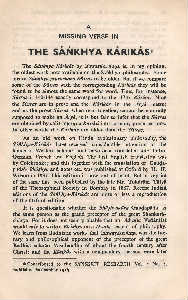Page 721 - Lokmanya Tilak Samagra (khand 2)
P. 721
A
~ .
MISSING VERSE IN
~
~
THE SANKHYA -KARIKAS"''"
The Satikhya Karikas by Ishwarakri,h:p.a is, in my opinioa,
the oldest work now available on the S&ilkhya philosophy. Some
regard Satikhya-pravachana-Sutras to be older. But if we compare
some of the Sutras with the corresponding Karikds they will be
found to be almost the same word for word. Thus, for instance,
Sutras i. 140-144 exactly correspond to the 17th Karika. Now
the Sutras are in prose and the Karikas in the Arya metre;
and as the prose Sutras, when read together, cannot be naturally
supposed to make a..n Aryd, it is but fair to infer that the Sutrcu
are obtained by splitting up a Karika into so many prose sections.
In other words the Karikds are older than the Sutras.
As an old work on Hindu evolutionary philosophy, the
Satikhya-Karikas have received considerable attention at the
hands of Western scholars and have been translated into Latin,
German, French and English. The first English translation was
by Colebrooke; and this together with the translation of Gau~a
pada's Bha~hya and notes etc. was published at Oxford by H. H.
Wilson in 1837. This edition is now out of print. But a reprint
of the same has been published by the late Mr. Tukaram Tatya
of the Theosophical Society in Bombay in 1887. Recent Indian
editions of the Sankhya-Karikds are more or less a reproduction
of the Oxford edition.
It is questionable whether the Bha~hyakara Gau~pada is
the same person as the grand preceptor of the great Shankara-
charya. For it does not seem probable that an Advaita Veda:ntist
would caie to write a Bhd~hya on a Dvaita system of philosophy.
We learn from Budhistic works that lshwaralcritthpa was the lite-
rary and philosophical opponent of the preceptor of the great
Budhist scholar Vasubandhu of about the fourth century after
Christ; and the Karikas with a commentary thereon were later
*Contributed to the SANSKRIT RESEARCH Vol. 1 No. 2,
published ia October 1915.

